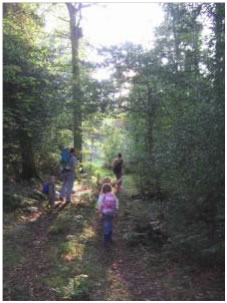
The Art of Natural Forest Practice
Celf Ymarfer Coedwig Naturiol

 |
The Art of Natural Forest Practice Celf Ymarfer Coedwig Naturiol |
 |
CROESO>>> |
| |
|
|
 |
HOW I UNLEARNED |
 |
Comment by PAUL GOETZEE, tree surgeon working at Coed Nant Gain It is probably true to say that the tree surgeon is rarely seen in the countryside. After all, trees in the countryside – that is to say, in woods - can look after themselves. So what is a tree surgeon doing working in a 20-acre ancient woodland in North Wales called Coed Nant Gain? Let me explain. Coed Nant Gain goes back 12,000 years to the retreat of the last Ice Age. Originally all the trees would have been native species- oak, ash, birch, alder, willow, aspen, holly, yew, Scots pine, hazel, elm, rowan and so on. Since then man has felled and cleared the woodland and introduced species from foreign places. Fashion and economics over the centuries have determined what trees were put in and what were taken out. Rarely has there been there any regard for what owner (or as he prefers it, ‘steward’) Iliff Simey calls ‘forest health’. Forest health is that delicate, intricate balance between living and dying things that makes the forest self-sustaining, rich and diverse - something very evident at Coed Nant Gain. Iliff’s plan is to put the clock back 12,000 years making Coed Nant Gain a demonstration of how the natural forest functions. He believes we have so much to learn from it. It’s a Herculean task and not one achievable in his or even his great great great grand children’s lifetimes. But he is making a start. Central to Iliff’s plan is the creation of glades. Nature makes glades by taking out trees through the excesses of weather and disease. Nature does things in her own time but unfortunately time is not on the side of the contemporary forest. So Iliff asks a tree surgeon to help him create glades in his wood. Central to Iliff’s plan is the creation of glades. Nature makes glades by taking out trees through the excesses of weather and disease. Nature does things in her own time but unfortunately time is not on the side of the contemporary forest. So Iliff asks a tree surgeon to help him create glades in his wood. It has been estimated that a healthy forest requires somewhere in the region of twenty five standing decaying trunks of the larger diameter trees per acre. These rotting towers provide homes for wood-boring insects which in turn provide food for woodpeckers and other birds. Fallen or windblown oaks, ash and beech lie in a tangled mass of branches. They recycle nutrients and are the food-store for future generations of this forest community. Iliff removes only a tiny fraction of the logs for his ever-burning woodstove and leaves the major part to restore the health of the forest. But work at Coed Nant Gain is not all about decay and regeneration. It is equally about transplanting seedling trees into more agreeable locations where they will thrive, grow straight and eventually make good timber trees. There are moments when I feel as if we are Ice Age people, relishing the purity and immensity of the primeval forest, the wild wood, sensing something moving through the trees, animating the plants and insects and animals, locating us in the great scheme of things, making us part of the wholeness of Life on this planet, at this particular point of evolution. Iliff provides conducted tours, explaining how the woodland works and what he is doing. Visitors are visibly uplifted, for the woodland is a healing place. One visitor took a deep breath and commented, “Oh the peace and tranquillity”. Another, “It’s so refreshing”. And yet another, “It’s so beautiful, like a poem”. People depart saying “Oh I feel refreshed”. Children love the adventure of exploring the woodland; mud, water, and possibly wild animals. They gain some understanding of the woodland and learn respect for the countryside. Iliff says many people come again, for the woodland obviously provides something that is lacking in our stressful 21st century. I have learned much working as a tree surgeon in Princess Gain’s forest in the valley, but probably what’s more important is what I’ve un-learned. I was trained to shape trees to man’s urban needs. Now I shape trees to the needs of the forest. Maybe some of these ideas could be transferred back to our towns and cities. A visit is essential to capture the sprit of the woodland and grasp what is so special about what Iliff is doing. FOR FURTHER INFORMATION please visit our website and telephone to arrange a visit to Coed Nant Gain. Iliff Simey |